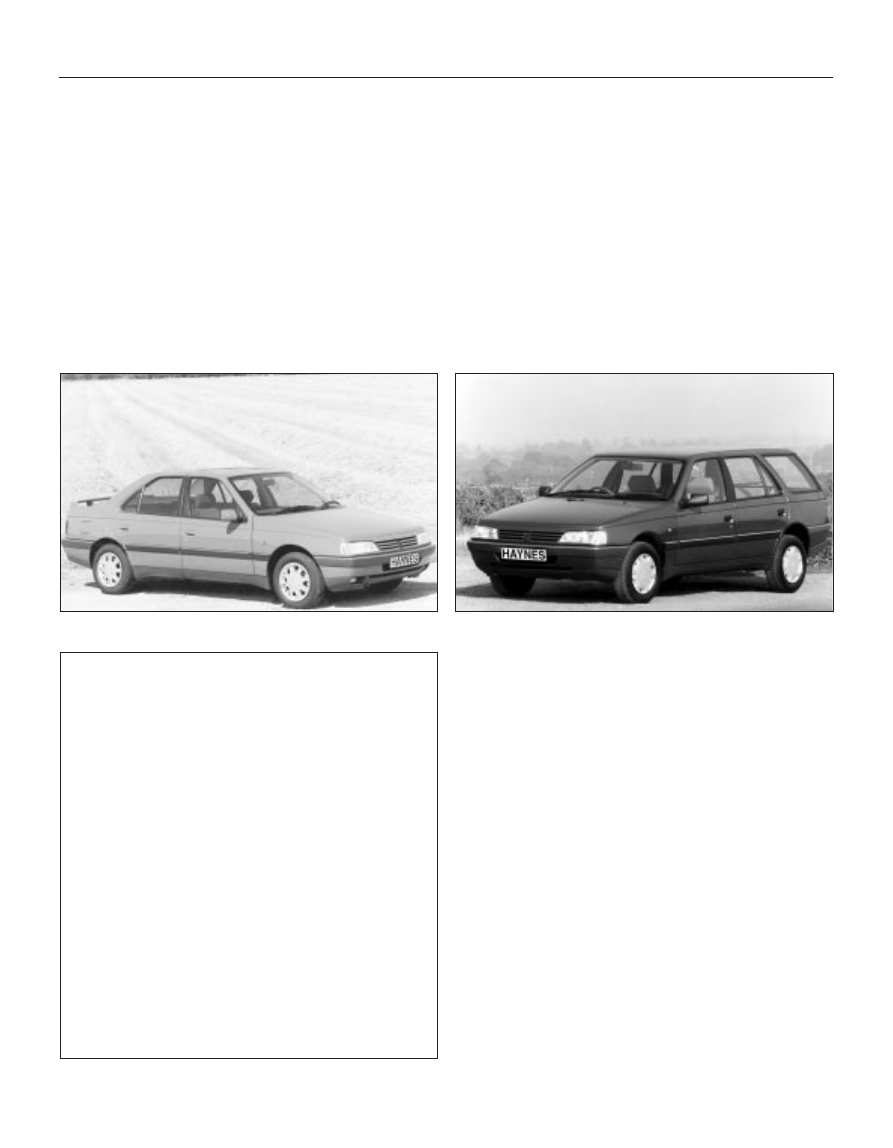содержание .. 1 2 3 ..
Peugeot 405. Manual - part 2

The Peugeot 405 model range was introduced into the UK in
January 1988 in Saloon form only.
Available with 1.6, 1.8, 1.9 and 2.0 engines, all models have front-
wheel-drive with all round independent suspension.
Automatic transmission models were introduced in April 1988.
In July 1988 came the sporty Mi 16 version with its 1.9 litre double
overhead cam, 16-valve engine, uprated gearbox, suspension and an
ABS braking system to match its power.
Estate car versions were introduced in October 1988.
From 1991, engines equipped with catalytic converters were
progressively introduced, to meet the more stringent exhaust gas
emission regulations.
Since its introduction, the 405 range has continually been
developed. All models have a high trim level, which is very
comprehensive in the upper model range.
For the home mechanic, the Peugeot 405 is a straightforward
vehicle to maintain and repair since design features have been
incorporated to reduce the actual cost of ownership to a minimum, and
most of the items requiring frequent attention are easily accessible.
Your Peugeot 405 Manual
The aim of this manual is to help you get the best value from your
vehicle. It can do so in several ways. It can help you decide what work
must be done (even should you choose to get it done by a garage),
provide information on routine maintenance and servicing, and give a
logical course of action and diagnosis when random faults occur.
However, it is hoped that you will use the manual by tackling the work
yourself. On simpler jobs, it may even be quicker than booking the car
into a garage and going there twice, to leave and collect it. Perhaps
most important, a lot of money can be saved by avoiding the costs a
garage must charge to cover its labour and overheads.
The manual has drawings and descriptions to show the function of
the various components, so that their layout can be understood. Then
the tasks are described and photographed in a clear step-by-step
sequence.
0•4
Introduction
Peugeot 405 SRi Saloon
Peugeot 405 GL Estate
Acknowledgements
Thanks are due to Champion Spark Plug who supplied the
illustrations showing spark plug conditions. Certain other illustrations
are the copyright of the Peugeot Talbot Motor Company Limited, and
are used with their permission. Special thanks to Gliddons of Taunton
who provided several of the project vehicles used in the origination of
this manual. Thanks are also due to Sykes-Pickavant Limited, who
provided some of the workshop tools, and to all those people at
Sparkford who helped in the production of this manual.
We take great pride in the accuracy of information given in this
manual, but vehicle manufacturers make alterations and design
changes during the production run of a particular vehicle of which
they do not inform us. No liability can be accepted by the authors
or publishers for loss, damage or injury caused by any errors in, or
omissions from, the information given.
Project vehicles
The vehicles used in the preparation of this manual, and which
appear in many of the photographic sequences, were a Peugeot 405
GL Saloon, a Peugeot 405 GTX Estate, a Peugeot 405 GR Saloon, and
a Peugeot GTX Saloon.
The Peugeot 405 Team
Haynes manuals are produced by dedicated and
enthusiastic people working in close co-operation. The
team responsible for the creation of this book included:
Authors
Steve Rendle
Andy Legg
Sub-editor
Carole Turk
Editor & Page Make-up
Bob Jex
Workshop manager
Paul Buckland
Photo Scans
John Martin
Paul Tanswell
Cover illustration & Line Art
Roger Healing
Wiring diagrams
Matthew Marke
We hope the book will help you to get the maximum
enjoyment from your car. By carrying out routine
maintenance as described you will ensure your car’s
reliability and preserve its resale value.